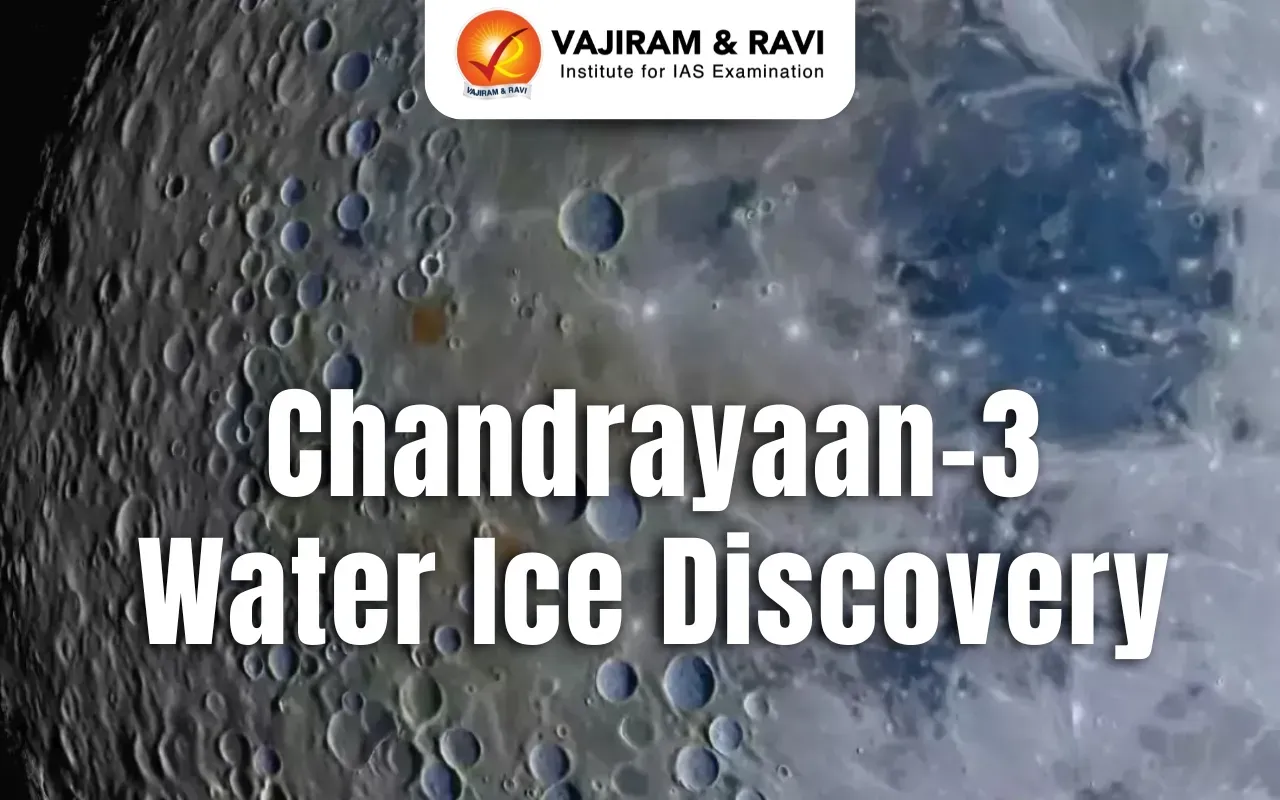What’s in Today’s Article?
- Chandrayaan-3 Latest News
- Introduction
- Chandrayaan-3 and Its Scientific Contributions
- Potential Presence of Water-Ice Beyond the Poles
- Implications for Future Lunar Exploration
- Conclusion
- Chandrayaan-3’s Water-Ice Discovery FAQs
Chandrayaan-3 Latest News
- In a new study, researchers from the Physical Research Laboratory (PRL) in Ahmedabad have found that the area of the moon where water ice can be easily accessed is greater than expected.
Introduction
- India’s Chandrayaan-3 mission has made a ground-breaking discovery regarding the presence of water-ice on the Moon.
- Previously believed to exist primarily in the Moon’s polar craters, new research based on data from the Chandra’s Surface Thermophysical Experiment (ChaSTE) suggests that water-ice might also be present in high-latitude regions beyond the poles.
- This revelation has major implications for future lunar exploration, as it could make water more accessible for human missions and space-based activities.
Chandrayaan-3 and Its Scientific Contributions
- Role of ChaSTE in Lunar Research
- The ChaSTE instrument, onboard the Vikram lander, was designed to measure surface and sub-surface temperatures of the Moon.
- It provided the first-ever in-situ temperature readings from high-latitude lunar regions.
- The findings revealed that even slight changes in altitude and slope orientation could result in significant temperature variations, creating potential environments similar to polar regions where water-ice can accumulate.
- Unexpected Temperature Variations
- High Surface Temperatures: The ChaSTE data showed that sun-facing slopes recorded temperatures as high as 82°C (355 K) at the Shiv Shakti point, where the Vikram lander had touched down.
- Cold Shaded Areas: In contrast, just a meter away on a flat surface, the temperature dropped to 59°C (332 K). The temperature varied drastically based on the inclination and exposure to sunlight.
- Extreme Night-time Cooling: At night, temperatures plummeted to -181°C, confirming the Moon’s vast thermal differences.
Potential Presence of Water-Ice Beyond the Poles
- Key Observations from the Study
- Scientists found that slopes tilted more than 14° away from the Sun maintained much lower temperatures, creating an environment where water-ice could migrate and stabilize beneath the surface.
- The study indicates that water-ice may not be confined to polar craters but could also exist in other high-latitude regions, particularly in shadowed areas.
- Significance of this Discovery
- Greater Accessibility for Space Missions
- Polar regions pose technical challenges for landings due to rugged terrain and constant shadow.
- High-latitude locations are easier to reach and explore, making water extraction more feasible.
- Supports Long-Term Lunar Habitation
- Water on the Moon is crucial for drinking, sanitation, and growing food for astronauts.
- Water-ice can also be converted into oxygen and hydrogen, providing breathable air and fuel for space travel.
- Commercial and Scientific Potential
- The ability to extract water locally reduces the need to transport it from Earth, making lunar missions more sustainable and cost-effective.
- The findings contribute to a better understanding of the Moon’s evolution and the behaviour of volatile substances in space.
- Greater Accessibility for Space Missions
Implications for Future Lunar Exploration
- Chandrayaan-3’s discovery aligns with global lunar exploration efforts, including NASA’s Artemis program, China’s plans for a lunar base, and Russia’s lunar lander missions.
- With more accessible water-ice deposits, India’s future lunar missions can now focus on resource utilization, setting the stage for permanent human presence on the Moon.
Conclusion
- Chandrayaan-3’s findings have significantly expanded our understanding of the Moon’s water distribution.
- The revelation that water-ice may exist beyond the poles reshapes lunar exploration strategies and enhances the feasibility of future human settlements on the Moon.
- By identifying high-latitude regions with favourable conditions, ISRO’s mission contributes not only to India’s space aspirations but also to the broader global efforts of deep-space colonization and resource utilization.
Chandrayaan-3’s Water-Ice Discovery FAQs
Q1. What did Chandrayaan-3 discover about water on the Moon?
Ans. Chandrayaan-3’s data suggests that water-ice might exist beyond the Moon’s polar regions in high-latitude shaded areas.
Q2. How does ChaSTE help in detecting water-ice?
Ans. ChaSTE measures temperature variations on the lunar surface and sub-surface, identifying potential regions where water-ice can accumulate.
Q3. Why is the discovery of water-ice beyond the poles significant?
Ans. It makes water more accessible for future lunar missions, supporting habitation and reducing dependence on Earth for resources.
Q4. How can lunar water-ice be used in space exploration?
Ans. Lunar water can be converted into drinking water, oxygen, and hydrogen fuel, making deep-space exploration more sustainable.
Q5. What are the next steps after Chandrayaan-3’s findings?
Ans. Future lunar missions will focus on confirming and extracting water-ice from these newly identified high-latitude regions.
Last updated on June, 2025
→ UPSC Notification 2025 was released on 22nd January 2025.
→ UPSC Prelims Result 2025 is out now for the CSE held on 25 May 2025.
→ UPSC Prelims Question Paper 2025 and Unofficial Prelims Answer Key 2025 are available now.
→ UPSC Calendar 2026 is released on 15th May, 2025.
→ The UPSC Vacancy 2025 were released 1129, out of which 979 were for UPSC CSE and remaining 150 are for UPSC IFoS.
→ UPSC Mains 2025 will be conducted on 22nd August 2025.
→ UPSC Prelims 2026 will be conducted on 24th May, 2026 & UPSC Mains 2026 will be conducted on 21st August 2026.
→ The UPSC Selection Process is of 3 stages-Prelims, Mains and Interview.
→ UPSC Result 2024 is released with latest UPSC Marksheet 2024. Check Now!
→ UPSC Toppers List 2024 is released now. Shakti Dubey is UPSC AIR 1 2024 Topper.
→ Also check Best IAS Coaching in Delhi






















